For a long time, the grocery line in our budget was a source of great stress. As two adults with a young child, my husband and I regularly managed to spend $1,000 or more a month on groceries. It was out of control. Not only were we wasting money, we were wasting food. Something had to change. So, last fall, we made a dedicated effort to stop wasting money on groceries!
Over the past several months we have cut our spending almost 50% while also drastically reducing how much we were spending on take-out. (Yes, take-out was a whole other section of our budget!) We throw out less food, spend less time cooking, and are generally enjoying our kitchen more.
But Ibotta cashback, while excellent, wasn’t what cut hundreds of dollars out of our spending. Here is how we finally slashed our grocery budget for good! Settle in – This is a long one!
Table of Contents
(1) Simplify Meal Planning – Don’t Fall Into the Pinterest Trap
Saving on groceries 101 is having a meal plan and sticking to it. Obviously going to the grocery store and just buying random things is going to mean spending a lot more. But creating a meal planning system that actually worked was hard for us at first. It required a lot of trial and error. Unsurprisingly, the end result was that we were making things way too complicated.
Stick to Your Favorites
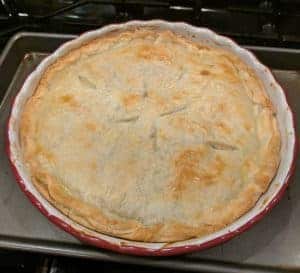
Since my husband and I both love cooking, Pinterest was a dangerous place for us. It would come time to meal plan, I would pull out my laptop, and we would start fresh every week looking for new, tasty things to try. Frequently, this meant an hour or more building a meal plan – before even creating the grocery list to make those meals!
Over time, we discovered this method was costing us way too much time and money. Busy weeks meant meal plans weren’t finished. A bad batch of recipes could mean lots of food waste and cereal for dinner.
The first step to meal planning success was creating a short-list of our favorite dinners. My husband and I brainstormed and ultimately came up with about 20 recipes we both loved. We tried for a mix of simple one-pan recipes, meals that cooked well in bulk, soups, and stews. Then we added a few of our more complicated top choices.
Now, when we meal plan, we stay far away from our computers! At the beginning of the week, I sit down and choose a handful of recipes from our top choice list and move on.
While this definitely saves us time, it also saves us money. I know what ingredients are in those common dishes and can make a grocery list quickly. We can buy some of the ingredients that go in multiple dishes in bulk, knowing we will use them. And we actually make the most of the food we cook!
Keep Your Go-To Recipes Accessible
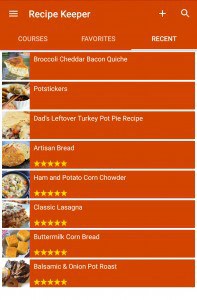
Once we had our list of favorite recipes, we had to get them all in one place. Some were in cookbooks, many from various blogs, and a couple stored inconveniently in my head. If it was my husband’s turn to cook and I was out of range, he didn’t always know where to find the recipe! This often ended up meaning late dinner or take-out.
We purchased an app called Recipe Keeper for the tablet we keep on our kitchen island and loaded all our favorite recipes. We also bought a copy for each of our phones, so we could sync recipes across devices. All in, it cost $15 for three copies of the Pro version, more than I hoped to spend.* I love that I can send recipes straight from a website or blog post to be loaded into the app – I hate hand copying recipes! – and the grocery list feature gets a ton of use.
If you want a cheaper option, print your go-to recipes and put them in a fun file folder in your kitchen. Or, buy an old-school recipe book and copy your recipes in there. Just make sure it is something you will keep up with and use. We’ve tried the old school pen and paper method, but I never made time to write out all the recipes so the system didn’t work for us.
*I did complain to the developer that they didn’t have a family share option, but we continue to use it as it is the best recipe app I’ve found.
Make Your Meal Plan Visible
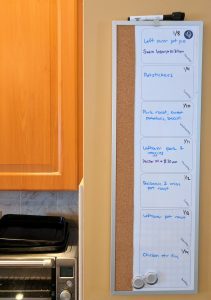 It is way too easy to go off track with your meal plan if you don’t remember what you are supposed to be eating any given night. Here’s the hard truth – If you scratch your meal plan on a piece of paper it is going to get lost (or ignored). Keeping it on your phone may work if it sends you alerts, but you still might get miscommunications among family members.
It is way too easy to go off track with your meal plan if you don’t remember what you are supposed to be eating any given night. Here’s the hard truth – If you scratch your meal plan on a piece of paper it is going to get lost (or ignored). Keeping it on your phone may work if it sends you alerts, but you still might get miscommunications among family members.
Our favorite way of tracking our meal plan is a weekly whiteboard that we hung right in the kitchen. I jot the meal plan on there each week, along with other family activities, and leave it at that. If someone wanders into the kitchen wondering what is for dinner, it is right there in black and white!
(2) Cook Less Times a Week – How to Embrace Leftovers
Cooking is great, but after three or four days in a row of making time to cook, do dishes, and pack up leftovers anyone would be exhausted! It was these tired days when we were burnt out, that we would end up succumbing to take-out. Even if there was food in the fridge!
The key to overcoming this struggle was cooking fewer times a week. Despite the fact that my family eats at home almost every single night, we only cook three to four days a week. We choose recipes that can last us two nights, freeze extra dishes for nights we just don’t have time and give ourselves the gift of frozen pot pie or potstickers when we just want to relax!
Have Recipes That Last Well in Your Arsenal
Personally, I would eat the same two or three meals every single day. But my husband, and frankly most people, find repetition frustrating. That, and choosing meals that just wilt in the fridge, are why so many families say, “we don’t eat leftovers.”
However, there are meals that actually hold up incredibly well for leftovers. Did you know that most Italian restaurants won’t serve lasagna the first day it is made? They think allowing it to cool and set in the fridge, then rewarming it, actually makes it hold its taste, shape, and texture better. Chili, stews, and fried rice are indifferent to being eaten the day of or the next day.
If your family absolutely won’t eat the same thing twice in a row, cook two nights, then take two nights off. For instance, make a large quiche on Monday and beef stew and biscuits on Tuesday. Then have the leftover quiche, which is still good, on Wednesday before finishing the stew on Thursday. Look for great, cheap meal prep recipes if your family needs more variety.
Try to time your leftover days with family activities. We never cook Thursday nights because my husband plays hockey those nights. Heating up some leftovers and not making new dishes makes it easier to get him out the door on time.
When Cooking Good Freezer Meals, Make a Little Extra
There are certain meals where I can’t remember the last time I made a single batch. Turkey soup, chili, pot stickers, meatloaf and more always get made in a double batch in our house. We stick the extras in mason jars, resealable bags, or FoodSaver sealed containers and check off another night in the future where we don’t have to cook.
This is different than Crock-Pot dump meals because it takes zero extra time. I’m indifferent to cooking one batch of something or two. I’m cooking anyway! Plus, we struggle with Crock-Pot freezer meals. My husband and I often find them mushy and lacking in flavor. But maybe that is just us!
Just be sure to keep a good freezer log of what you have already made, so you can take full advantage of your prep during busy weeks or nights. There are some more details on our favorite freezer organization method when we talk about meat below.
Tips for freezing meals effectively:
- Label everything. I like the dissolvable mason jar stickers for our jars and Tupperware, but Sharpie or washable labels will work just fine as well.
- Let any food cool COMPLETELY before putting it in the freezer. For soups, I even like to let it cool, then transfer to the fridge overnight before freezing.
- Flash freeze small foods first. For things like pot stickers, meatballs, or muffins, that might stick together, flash freeze first. Separate them out on a cookie sheet or cooling rack and put that in the freezer for an hour. Then dump the pre-frozen items in a Tupperware or resealable bags. This way, you can make just a handful or the whole batch as you need.
- Vacuum seal any meats or prepared dishes. Vacuum sealing is an extra step, but it does prevent freezer burn and preserve the texture better (in our experience) over time. We have the cheapest FoodSaver and have been using it for three years with no issue. You can buy it here.
- Note that vacuum sealers are commonly found at Costco and BJs, but they are often the heavier duty units with lots of add-ons. Make sure you will actually need/use what is in the box before purchasing there.
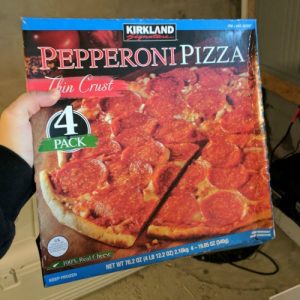
Allow an Occasional Frozen Prepared Food Night
Despite all our efforts and planning, sometimes you just don’t want to cook. The kids are asking for chicken nuggets or you want to drop a pizza in the oven and call it a night. That’s fine! Just don’t let it completely bust your budget.
Our drop freezer always has a couple Kirkland frozen pizzas from Costco (they are actually pretty good!), ravioli, and chicken tenders. They take only minutes to prepare and don’t even require going out to pick up take-out. The nights we don’t want to cook, we shift our meal plan out a night and grab something quick instead. No shame. That’s why the whiteboard is erasable, right?
The difference is, a Costco frozen pizza costs us $2.50 a pie. A delivery pizza from the local place in town costs $22, due to order minimums and tips. Not a bad deal!
(3) Decide Where Organic is Important to You
Part of our hefty budget in the past was that we bought every single item organic. I have a bit of a paranoia about chemicals and hormones in our food, especially as Fuss Fish is little and I’ve been pregnant. But eating organic Oreos wasn’t exactly logical (still very little healthy about cookies!). And it was ramping up our grocery spending like crazy.
We did some serious family discussion about where and why organic was important to us. We tried a few methods, and here is how we ultimately cut down.
Focusing Dollars on “Dirty Dozen” Produce
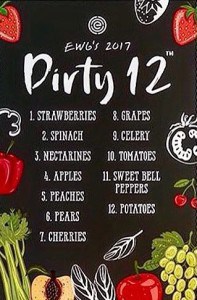
According to Harvard Medical and many other researchers, the verdict is still out on the impact of higher pesticide and residues on conventionally grown food. Plus, the absolute difference in residues is exceedingly minor, with levels for both organic and conventional food within “safe” ranges. (Did you know organic doesn’t mean there aren’t any pesticides? It just means different ones?)
Despite this scientific uncertainty, I remain cautious. Especially when it comes to the boys. My grandfather, who didn’t smoke and rarely drank, died of cancer at 62. My first boss, who was running 10Ks only a year before he passed, died of brain cancer in his 50s. Who knows why, but I don’t want to take chances I don’t need to. My husband and I decided the best route for us was to stick to the “Dirty Dozen”.
Each year EWG (the Environmental Watch Group) puts out a list of the 12 types of produce with the highest pesticide residue. The 2018 list isn’t out yet, but you can find the 2017 list here. For those 12 foods, we buy organic or wait until they are in season. Nectarines and peaches, for example, we only eat when the season is right to pick them ourselves!
This year, we will also be revamping our garden. We took a break after Fuss was born because it seemed too overwhelming, but we think the benefits for cost and health will be more than worth it in 2018 and beyond!
Considering Whether Organic Animal Crackers are Really Worth it

A big part of reducing our budget was limiting the number of processed foods we buy. We make muffins and pancakes from scratch. I bake many of our breads. I even keep frozen individual balls of homemade cookie dough. That way we can make a handful if we want to give Fuss a treat or have some as dessert.
But sometimes, by golly, I’m not above giving my kid an animal cracker. In those moments of humanity, I’m not sure the difference between an organic one or a regular one makes all that much difference. Except that the price is double.
After discussing our priorities, my husband and I decided to not stress ourselves out over the little things. Sometimes Fuss is going to eat things I wish he didn’t. But as long as he eats the good stuff far more than the bad, I know he’ll be fine. Plus, this gives us the excuse to sneak an occasional Oreo!
Those occasional small purchases where organic means spending $2-$3 more add up quickly. Just switching to following the Dirty Dozen and allowing ourselves a few regular processed goods made a huge difference to our budget. Not to mention, those conventional foods go on sale far more often!
Why We Still Buy Local, Organic, Hormone-Free Meat & Dairy
Like everything else with the organic movement, it is up for debate whether conventionally raised meat and dairy is actually causing issues like early puberty and antibiotic-resistant illnesses. I’m not a doctor and the number of variables that play into our health makes proving causation incredibly hard. However, conventionally raised meat and dairy are definitely bad for the environment and for the animal. Not to mention the pollution from just shipping these products around the country.
For the sake of caution, and our tree-hugging natures, we decided to continue to buy local meat and dairy. A vegetarian lifestyle wasn’t in the cards for us and this seemed like a fair compromise. However, we were no longer going to waste our grocery budget on the insane prices of meat at Whole Foods. We started to truly seize the concept of local to reduce our cost per pound. More on how we did it in the next tip!
(4) Buy Meat in Bulk – Reduce Your Price Per Pound
In late 2015, we bought a drop freezer from Costco in advance of Fuss Fish’s birth. The plan was that it would be good to have a little extra space to store pumped breastmilk. We also wanted to do some freezer meal prep before he was born. However, this lovely addition to our basement didn’t get a lot of use until the last year or so. Now, I love it dearly!
Having a drop freezer meals we can buy meat in bulk. In a well-maintained drop freezer, meat can stay fresh for 6 to 12 months!
Skip the Grocery Store – Find Your Local Farmer
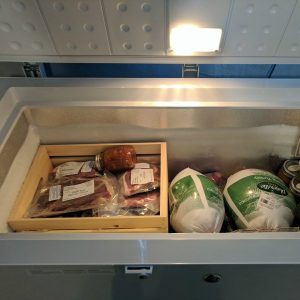
Often times, buying beef, chicken, and pork at your local farmer’s market costs just as much as stocking up at the grocery store. But that doesn’t mean your farmer doesn’t offer better prices! When we decided to start buying our meat in bulk, we searched for farmers in our area that offered large quantity discounts. Then we made some calls.
We weren’t ready to buy a quarter- or half-cow without testing our abilities to handle managing the freezer, which can run you 100 to 250 pounds of beef, but we did want to try ordering a mix of cuts. Ideally, we also wanted a farmer who could source pork and chicken for us as well.
Ultimately, we found a farmer about 45-minutes from our house who offered what he calls a “Family Pack”. It was 50 pounds of natural beef, half ground beef and half steaks, roasts, and kabobs for $8/lb. Since just grass-fed ground beef costs $8.79/lb at our local grocery store, this was a good deal! We ordered a family pack of beef, 20 pounds of assorted pork cuts, and 5 whole chickens. All in, it came to about $6.75/lb and five months later we are still finishing our stock! We estimate we pay over 40% less for our protein today than we did buying it piecemeal at the grocery store, even when we took advantage of sales.
Sometime this spring, we plan to order a quarter-cow to supply all our red meat needs for the year. Don’t worry, I’ll be covering what you get when you buy over 100 pounds of beef at one time right here!
Community buying
If you don’t have a drop freezer, or simply don’t have the need for as much beef or pork as our family goes through, don’t think you have to miss out on the savings. Reach out to local friends and family to see if they would like to split an order with you! That way, you get a more manageable amount of protein, save money, and support a local farmer!
Finding a local farm
Usually, Google or your local farmer’s market are plenty to find a source of low-cost, bulk meat or fish. Many farms offer bulk purchases, even if they aren’t listed on their website. Call a few farms and ask about pricing.
Understanding small farm organic
The regulations around organic are set by the USDA and they focus on rules for larger farms. The cost to receive the certification and impose the reporting requirements required is often impossible for small farms, even if they follow more stringent guidelines than technically required.
Where we buy our meat, the farmer can only call his beef “natural”, not organic. But all his cattle are grass fed, receive no hormones, antibiotics or implants, and are humanely slaughtered. My husband and Fuss walked around his farm when we picked up our meat and had a great time. My biggest piece of advice is to talk to your farmer. Find someone whose practices you trust and don’t pay extra thinking the organic label always means one local farm is better than another.
Shop Post Holiday Meat Sales

Even with our bulk meat purchases, we don’t get the full variety of protein we like to eat from the farm. Things like turkey or whole hams we buy in the store. But only when the price makes sense.
This year we went to Costco the Saturday after Thanksgiving (sorry, but I am not going to any store on Black Friday). Their organic turkeys were not only on sale, there was a $20 rebate per bird with no purchase limit. We bought three 15-pound turkeys for an average price of less than $2/lb and added them to our freezer supply.
A week or so after Thanksgiving, we cooked the first turkey. With the meat from that one turkey, we made 11 meals for our family at an all in cost of less than $5 per meal for the whole family. Now, we didn’t eat them all at once. I froze some pre-cooked turkey for a large pot pie a few weeks later, plus 6 quarts of turkey soup. Those three birds will provide all our turkey needs for the whole year, and over a month of super low-cost dinners!
Similar protein sales are usually available after Christmas (ham or roasts), Easter (ham), and St. Patrick’s Day (corned beef). Be on the lookout for grocery stores looking to clear out their stock. You might not be able to find the perfect size cut, but the savings will be worth it!
Keep a Freezer Log
Alright, at this point we’ve got pre-cooked meals, baked goods, and meat all stored in our freezer. How do you make sure that food doesn’t go to waste? And how do you manage what is in there without digging through it every time you want to meal plan?
Making sure we were rotating through what was in our freezer took some time for us to master. We tried (and failed) to keep a paper log taped to the freezer cover. Next, we tried a number of pantry management apps. Then, we would end up just standing in the basement and making a meal plan while we looked in the freezer. (That last one is terrible for energy management. Oops.) Ultimately, we decided to try one more app, hoping that it would work for us.
We use the No Waste app almost every day to track what is in our freezer and our pantry. I love that it lets you track expiration dates and alerts you to which foods need to be eaten to avoid waste. Also, the fact that it sits right under our meal board in the kitchen makes it super easy to update when we pull things out to thaw the day or two before we are due to use them. The only unfortunate feature for us is that it is currently only on iOS. So while it works great for our tablet, we can’t sync the app to our phones. Hopefully, it comes out on Android soon!
Try out the No Waste app or a free freezer management worksheet (Pinterest has dozens) and find what works for you. Your freezer can create as much food waste as your fridge or pantry if not managed. It just happens much more slowly.
Also, when you are new to managing a freezer, I highly recommend setting alerts on your phone to remove food a day or two before you need it. Most meat tastes better and maintains its texture if thawed slowly in the fridge. Once in a while, thawing meat in a cool bowl of water on the counter can get the job done safely in an afternoon. But leaving any raw ingredients out on the counter to come to room temperature is dangerous for bacteria generation.
(5) Price Shop Box Store Groceries – It Isn’t Always Cheaper
The final step to cutting our grocery budget in half was getting honest about our Costco spending. We pay $60 a year for our membership and weren’t entirely sure it was worth it. We don’t buy a lot of the processed goods that are sold in bulk at Costco. And our local Wegmans has great store-brand products and offers some pretty fantastic sales on items we buy regularly. Here is how we finally pared down our Costco shopping.
Taking the Time to Know the Real Price Difference
As I’m sure you all know by now, I am a total spreadsheet nerd. Before I make any decision, I need all the data. So, I made a list in Excel of the 32 items we buy most often. Wegmans allows you to look up current prices on their website (hooray for price transparency!) so I filled in those prices for all items. Then I printed a copy of the sheet with a blank column for Costco prices, packed up Fuss Fish, and headed off for the store.
In running a full price comparison, far fewer items were cheaper than the grocery store price than I expected. Even after correcting for packaging size. Organic eggs, for one, were far cheaper. As were blueberries (the little man’s favorite). But things like butter, orange juice, grapes, and broccoli crowns were the same price, if not slightly more expensive. Greek yogurt was less expensive, but only slightly and we would have to get a no-fat version instead of the full-fat we prefer.
I created a short list of the 6-7 products we would buy at Costco, in addition to fuel. Anything that was about the same price we opted for the regular grocery store. My reasoning was that we wouldn’t have to buy in bulk and we were more likely to get coupons at the regular grocery store. Not to mention that we have to use our debit card at Costco since we don’t have a Visa. No double credit card rewards!
Finally, looking at prices, we decided those handful of products were worth keeping the membership. Fuel is much cheaper at Costco and the products that were cheaper, like flour* and eggs, were things we used a lot of. The key was sticking like glue to our list!
*Things like flour and rice can go rancid if not used quickly enough or if they get moisture in them. Plus, the bags they come in are just asking for mice if left in the basement. We keep our flour, rice, and sugar in these airtight containers. Are they sold for dog food? Maybe, but they are still BPA-free food grade plastic and are one-third the price of the ones from Rubbermaid made for commercial kitchens.
Only Hit Costco Once a Month
Since we only buy a few items at Costco, we don’t have to go that often. Every three to four weeks will suffice. The less we go, the fewer chances we have to buy things we don’t need. Or eat all the samples as we walk around!
Usually, how often we go is dictated by how many racks of eggs we can fit in our fridge. We easily go through 2 dozen eggs a week and Fuss is not even two-years-old yet. If we want to cut our grocery budget beyond the 50% we have achieved, we seriously need some chickens… Oh, town ordinances, you are no fun!
Spending Less on Groceries Isn’t Complicated – You Just Need Simple Planning
Prior to finally digging in last fall, my husband and I exceeded our grocery budget almost every single month we were together. The grocery category just seemed like a black hole. The more methods we tried, the more time we spent on Pinterest and staring at cookbooks, the more frustrated we got. I hated throwing out food and that expense line made my blood boil.
But, like everything else in life, figuring it out meant looking inward. Once we decided to define our priorities, stop complicating the things we liked to eat, and take the 30 minutes every week or two to plan, things got easier. We stress less about grocery shopping now and rarely have a dinner we don’t enjoy. Oh, and we spend half of what we used to!
If you take the time to make planning simple and convenient, you can cut your grocery spending too! It is just a matter of determining what is important to you.
Do you struggle to manage your food spending? What are your biggest difficulties? Share in the comments – I’m sure we’ve experienced the same!



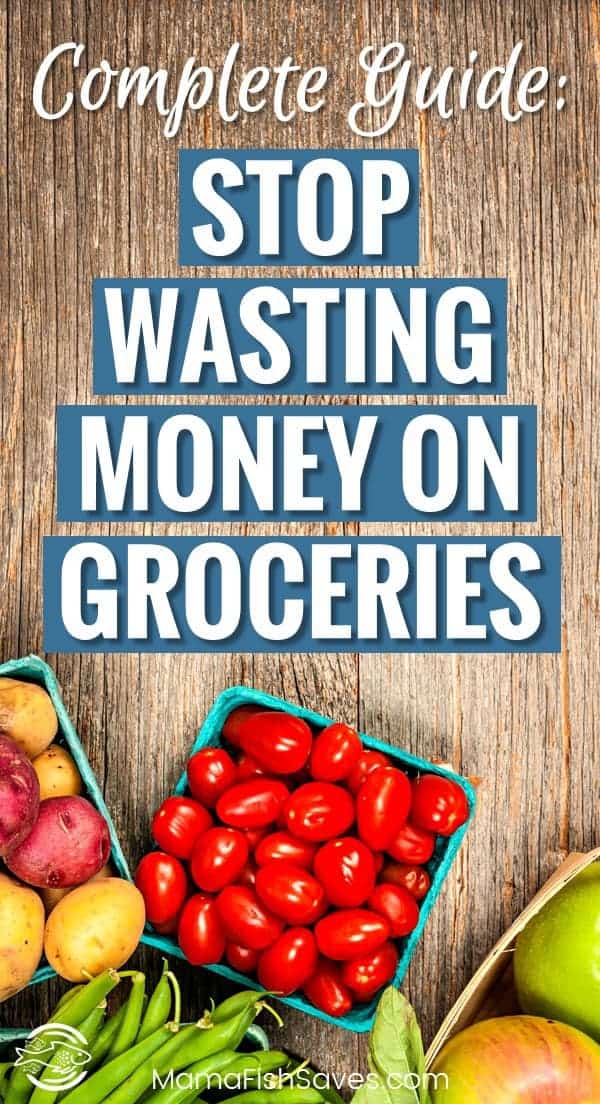

Epic post! I moved from white to brown eggs. I mistakenly thought brown eggs were better for you, they have nutritional difference! And white eggs much cheaper. I also looked into the organic requirements for eggs and it is very loose. Unless you go for real farm eggs there is not a lot of difference for the hens. So IMO either go for proper farm eggs or go cheap. A halfway house does nothing.
*no* nutritional difference
Oh yeah, brown vs white just depends on the type of chickens the eggs come from. I will have to look into the different requirements for organic eggs vs not, since we are still buying organic. We try to get them from a farm or friend when we can, but it isn’t always possible
This is a great post. I especially love the tips of eating healthy simple meals and only cooking a few times a week. Things tend to get lost in our freezer, so the freezer app sounds like a good idea, but I know myself and I won’t use it. But if we just keep frozen meat there then I can do quick weekly inventories. We are on a mission to reduce our spending so thanks for these great tips! How much do you spend per month now?
The freezer app definitely takes some practice! It helps that we have the tablet that sits in the kitchen because we just update the list when we move things from the freezer to the fridge.
We spend ~$550 per month now, including setting aside some cash for our meat purchases that only happen a couple times a year.
So many great tips! I’ve never thought of keeping a freezer inventory but that’s such a good idea. We stock up and freeze meat and are good about using that but if we freeze leftovers they often get lost in the deep freeze.
I’m a big fan of Pinterest for recipes but lately, I’ve been going back to my tried and true pins instead of seeking out new recipes. You just never know how well a recipe from Pinterest will turn out.
Tried and true is the way to go! We didn’t have much bad luck with Pinterest, but it did happen and the time lost searching for recipes just wasn’t worth it. I hope a freezer inventory helps you use more of the leftovers you store!
Good tips! Actually tomorrow (today? It’s late) I’ll be making a 3x batch of chicken pot pies and 2 will go in the deep freeze.
Oh, and Evernote is another option for recipes. I moved to that from another app that went belly-up.
Pot pies are so great to make in bulk! Especially since it usually means we use a whole thing of chicken stock, instead of needing to pair that meal with another recipe that needs stock so it doesn’t go to waste.
How does Evernote work? Can you import entire recipes or is it just where you save links to things you like? I’ve fiddled with almost all our recipes, so I like being able to edit them. Our Recipe Keeper app can pull from most websites, and then I play with them from there, which is a nice feature.
Amazing post – thank you! Would you share your “top 20” recipes with us? ? I HATE meal planning. 13 years of cooking…you would think I would have it down!
Definitely! I will put together a post with those recipes. Meal planning can be such a pain, but it is much easier when you are pulling from a smaller list.
Such an awesome post, Chelsea! I absolutely hate food waste and already incorporate a lot of what you suggest here, but will be adding the rest to our arsenal.
So glad you enjoyed it, Cody! Hope it helps you cut your waste even more!
Easy way to save. Eat much less or no meat. Replace with plant based proteins: lentils, black beans, quinoa, etc. which range from .$1 – $5 lb. Also you don’t have to pay energy cost of freezing since plant based proteins have along shelf life at room temperature.
A great idea for a lot of families! Eating less meat certainly does save money. We have added some meatless days into our meal plans, but going fully vegetarian isn’t in the cards for us.
This is great! I’ve taken “cutting our grocery bill” on as a challenge this year. Like you, we were over $1,000/month. Do you have a zaycon referral code you’d like us to use?
Thank you! Good luck with your challenge! I’m sure you’ll be able to cut back a lot.
For Zaycon, I do have a referral link! Thanks for asking 🙂 Here it is: https://smartmoneymamas.com/Zaycon-Fresh
Would you mind sharing the name of the farm that you bought the Family Pack of meat from ? Thanks!
Absolutely! The name of the farm is Lyn-Dell farm. They also have a meat CSA if you don’t want to get your order in such large chunks. Link below 🙂
https://www.lyn-dell.com/
Thanks! I’ll check them out.